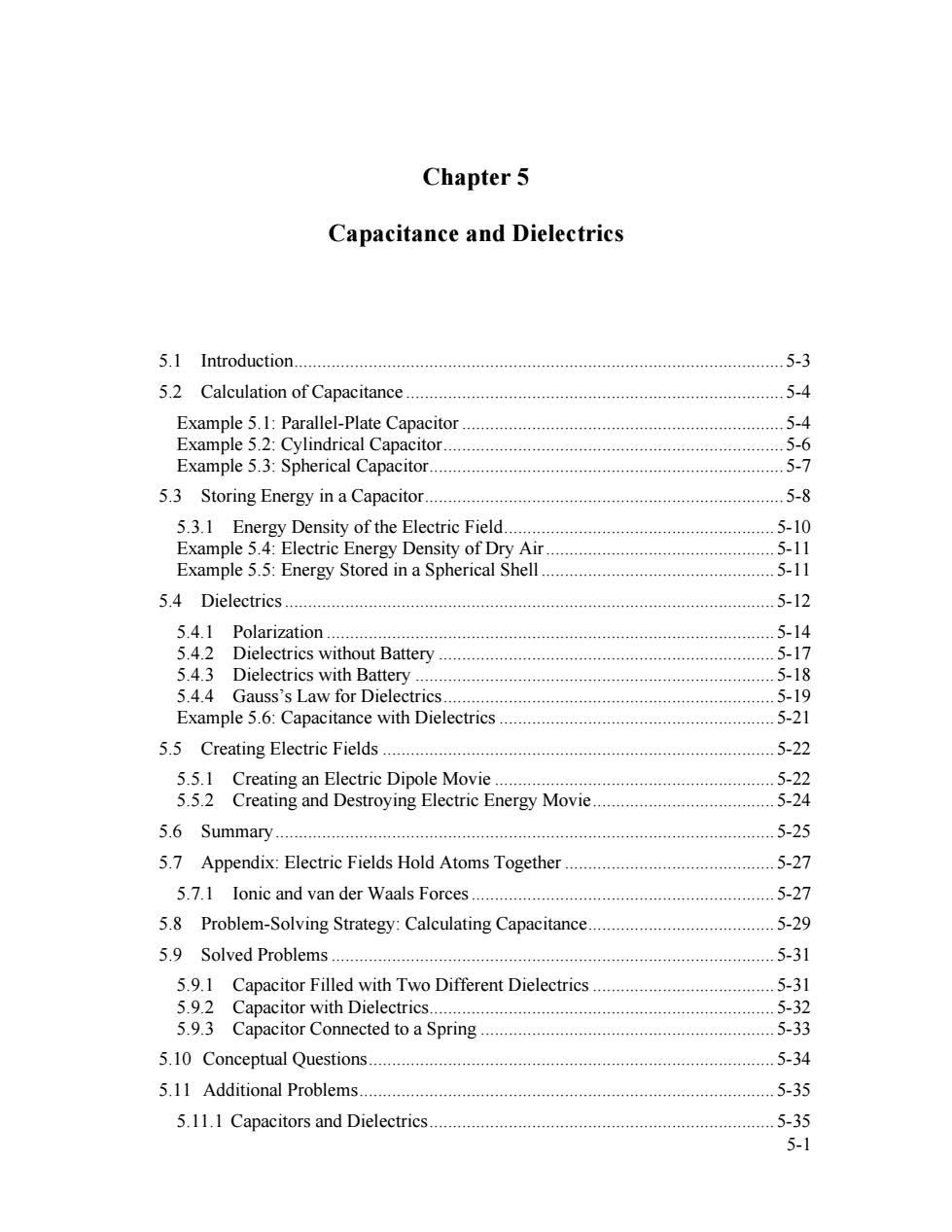
Chapter 5 Capacitance and Dielectrics 5.1 Introduction.. 5-3 5.2 Calculation of Capacitance................ 5-4 Example 5.1:Parallel-Plate Capacitor............ 5-4 Example 5.2:Cylindrical Capacitor 5-6 Example 5.3:Spherical Capacitor............... 5-7 5.3 Storing Energy in a Capacitor. 5-8 5.3.1 Energy Density of the Electric Field..... 5-10 Example 5.4:Electric Energy Density of Dry Air 5-11 Example 5.5:Energy Stored in a Spherical Shell 5-11 5.4 Dielectrics.. 5-12 5.4.1 Polarization............ 5-14 5.4.2 Dielectrics without Battery.............. 5-17 5.4.3 Dielectrics with Battery................ .5-18 5.4.4 Gauss's Law for Dielectrics.... 5-19 Example 5.6:Capacitance with Dielectrics..... 5-21 5.5 Creating Electric Fields................... 5-22 5.5.1 Creating an Electric Dipole Movie......... .5-22 5.5.2 Creating and Destroying Electric Energy Movie.................... .5-24 5-25 5.6 Summary.......….……….5- 5.7 Appendix:Electric Fields Hold Atoms Together.5-27 5.7.1 Ionic and van der Waals Forces.5-27 5.8 Problem-Solving Strategy:Calculating Capacitance...............5-29 5.9 Solved problems531 5.9.1 Capacitor Filled with Two Different Dielectrics......5.-31 5.9.2 Capacitor with Dielectrics................ .5-32 5.9.3 Capacitor Connected to a Spring................. 5-33 5.10 Conceptual Questions.................. 5-34 5.11 Additional Problems.................. 5-35 5.11.1 Capacitors and Dielectrics.............. 5-35 5-1
5-1 Chapter 5 Capacitance and Dielectrics 5.1 Introduction......................................................................................................... 5-3 5.2 Calculation of Capacitance ................................................................................. 5-4 Example 5.1: Parallel-Plate Capacitor..................................................................... 5-4 Example 5.2: Cylindrical Capacitor......................................................................... 5-6 Example 5.3: Spherical Capacitor............................................................................ 5-7 5.3 Storing Energy in a Capacitor............................................................................. 5-8 5.3.1 Energy Density of the Electric Field.......................................................... 5-10 Example 5.4: Electric Energy Density of Dry Air................................................. 5-11 Example 5.5: Energy Stored in a Spherical Shell.................................................. 5-11 5.4 Dielectrics......................................................................................................... 5-12 5.4.1 Polarization ................................................................................................ 5-14 5.4.2 Dielectrics without Battery ........................................................................ 5-17 5.4.3 Dielectrics with Battery ............................................................................. 5-18 5.4.4 Gauss’s Law for Dielectrics....................................................................... 5-19 Example 5.6: Capacitance with Dielectrics ........................................................... 5-21 5.5 Creating Electric Fields .................................................................................... 5-22 5.5.1 Creating an Electric Dipole Movie ............................................................ 5-22 5.5.2 Creating and Destroying Electric Energy Movie....................................... 5-24 5.6 Summary........................................................................................................... 5-25 5.7 Appendix: Electric Fields Hold Atoms Together ............................................. 5-27 5.7.1 Ionic and van der Waals Forces................................................................. 5-27 5.8 Problem-Solving Strategy: Calculating Capacitance........................................ 5-29 5.9 Solved Problems............................................................................................... 5-31 5.9.1 Capacitor Filled with Two Different Dielectrics....................................... 5-31 5.9.2 Capacitor with Dielectrics.......................................................................... 5-32 5.9.3 Capacitor Connected to a Spring ............................................................... 5-33 5.10 Conceptual Questions....................................................................................... 5-34 5.11 Additional Problems......................................................................................... 5-35 5.11.1 Capacitors and Dielectrics.......................................................................... 5-35
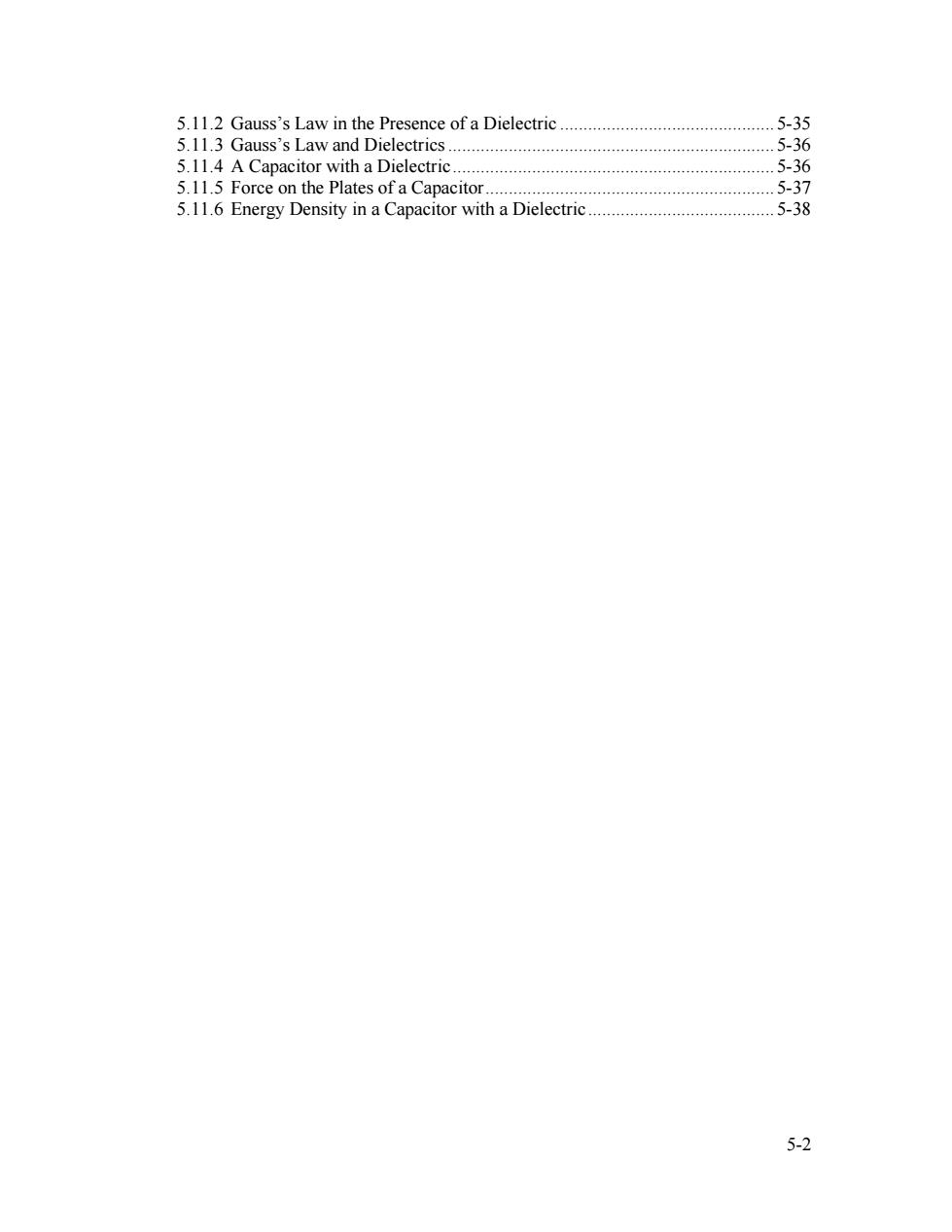
5.11.2 Gauss's Law in the Presence of a Dielectric...5-35 5.11.3 Gauss's Law and Dielectrics.5-36 5.11.4 A Capacitor with a Dielectric5-36 5.11.5 Force on the Plates of a Capacitor.... 5-37 5.11.6 Energy Density in a Capacitor with a Dielectric................................. 5-38 5-2
5-2 5.11.2 Gauss’s Law in the Presence of a Dielectric .............................................. 5-35 5.11.3 Gauss’s Law and Dielectrics...................................................................... 5-36 5.11.4 A Capacitor with a Dielectric..................................................................... 5-36 5.11.5 Force on the Plates of a Capacitor.............................................................. 5-37 5.11.6 Energy Density in a Capacitor with a Dielectric........................................ 5-38

Capacitance and Dielectrics 5.1 Introduction A capacitor is a device that stores electric charge.Capacitors vary in shape and size,but the basic configuration is two conductors carrying equal but opposite charges(Figure 5.1.1).Capacitors have many important applications in electronics.Some examples include storing electric potential energy,delaying voltage changes when coupled with resistors,filtering out unwanted frequency signals,forming resonant circuits and making frequency-dependent and independent voltage dividers when combined with resistors. Some of these applications will be discussed in latter chapters. Figure 5.1.1 Basic configuration of a capacitor. In the uncharged state,the charge on either one of the conductors in the capacitor is zero. During the charging process,a charge o is moved from one conductor to the other one, giving one conductor a charge,and the other one a charge -O.A potential difference Al is created,with the positively charged conductor at a higher potential than the negatively charged conductor.Note that whether charged or uncharged,the net charge on the capacitor as a whole is zero. The simplest example of a capacitor consists of two conducting plates of area A,which are parallel to each other,and separated by a distance d,as shown in Figure 5.1.2. Figure 5.1.2 A parallel-plate capacitor Experiments show that the amount of charge o stored in a capacitor is linearly proportional to Al,the electric potential difference between the plates.Thus,we may write 5-3
5-3 Capacitance and Dielectrics 5.1 Introduction A capacitor is a device that stores electric charge. Capacitors vary in shape and size, but the basic configuration is two conductors carrying equal but opposite charges (Figure 5.1.1). Capacitors have many important applications in electronics. Some examples include storing electric potential energy, delaying voltage changes when coupled with resistors, filtering out unwanted frequency signals, forming resonant circuits and making frequency-dependent and independent voltage dividers when combined with resistors. Some of these applications will be discussed in latter chapters. Figure 5.1.1 Basic configuration of a capacitor. In the uncharged state, the charge on either one of the conductors in the capacitor is zero. During the charging process, a charge Q is moved from one conductor to the other one, giving one conductor a charge, and the other one a charge !Q . A potential difference !V is created, with the positively charged conductor at a higher potential than the negatively charged conductor. Note that whether charged or uncharged, the net charge on the capacitor as a whole is zero. The simplest example of a capacitor consists of two conducting plates of area A, which are parallel to each other, and separated by a distance d, as shown in Figure 5.1.2. Figure 5.1.2 A parallel-plate capacitor Experiments show that the amount of charge Q stored in a capacitor is linearly proportional to !V , the electric potential difference between the plates. Thus, we may write

Q=CI△V|. (5.1.1) where C is a positive proportionality constant called capacitance.Physically. capacitance is a measure of the capacity of storing electric charge for a given potential difference AV.The SI unit of capacitance is the farad [F]: 1 F=1 farad 1 coulomb/volt=1C/V A typical capacitance that one finds in a laboratory is in the picofarad(1 pF=102F)to millifarad range,(1 mF=10-F=1000uF;1uF=10-F). Figure 5.1.3(a)shows the symbol that is used to represent capacitors in circuits.For a polarized fixed capacitor that has a definite polarity,Figure 5.1.3(b)is sometimes used. 。长 (a (b) Figure 5.1.3 Capacitor symbols. 5.2 Calculation of Capacitance Let's see how capacitance can be computed in systems with simple geometry. Example 5.1:Parallel-Plate Capacitor Consider two metallic plates of equal area 4 separated by a distance d,as shown in Figure 5.2.1 below.The top plate carries a charge +O while the bottom plate carries a charge-O.The charging of the plates can be accomplished by means of a battery,which produces a potential difference.Find the capacitance of the system. +0 Figure 5.2.1 The electric field between the plates of a parallel-plate capacitor Solution:To find the capacitance C,we first need to know the electric field between the 5-4
5-4 Q = C | !V |. (5.1.1) where C is a positive proportionality constant called capacitance. Physically, capacitance is a measure of the capacity of storing electric charge for a given potential difference !V . The SI unit of capacitance is the farad [F]: 1 F = 1 farad = 1 coulomb volt= 1C V . A typical capacitance that one finds in a laboratory is in the picofarad (1 pF = 10!12 F ) to millifarad range, (1 mF = 10!3 F=1000µF; 1µF = 10!6 F ). Figure 5.1.3(a) shows the symbol that is used to represent capacitors in circuits. For a polarized fixed capacitor that has a definite polarity, Figure 5.1.3(b) is sometimes used. (a) (b) Figure 5.1.3 Capacitor symbols. 5.2 Calculation of Capacitance Let’s see how capacitance can be computed in systems with simple geometry. Example 5.1: Parallel-Plate Capacitor Consider two metallic plates of equal area A separated by a distance d, as shown in Figure 5.2.1 below. The top plate carries a charge +Q while the bottom plate carries a charge –Q. The charging of the plates can be accomplished by means of a battery, which produces a potential difference. Find the capacitance of the system. Figure 5.2.1 The electric field between the plates of a parallel-plate capacitor Solution: To find the capacitance C, we first need to know the electric field between the
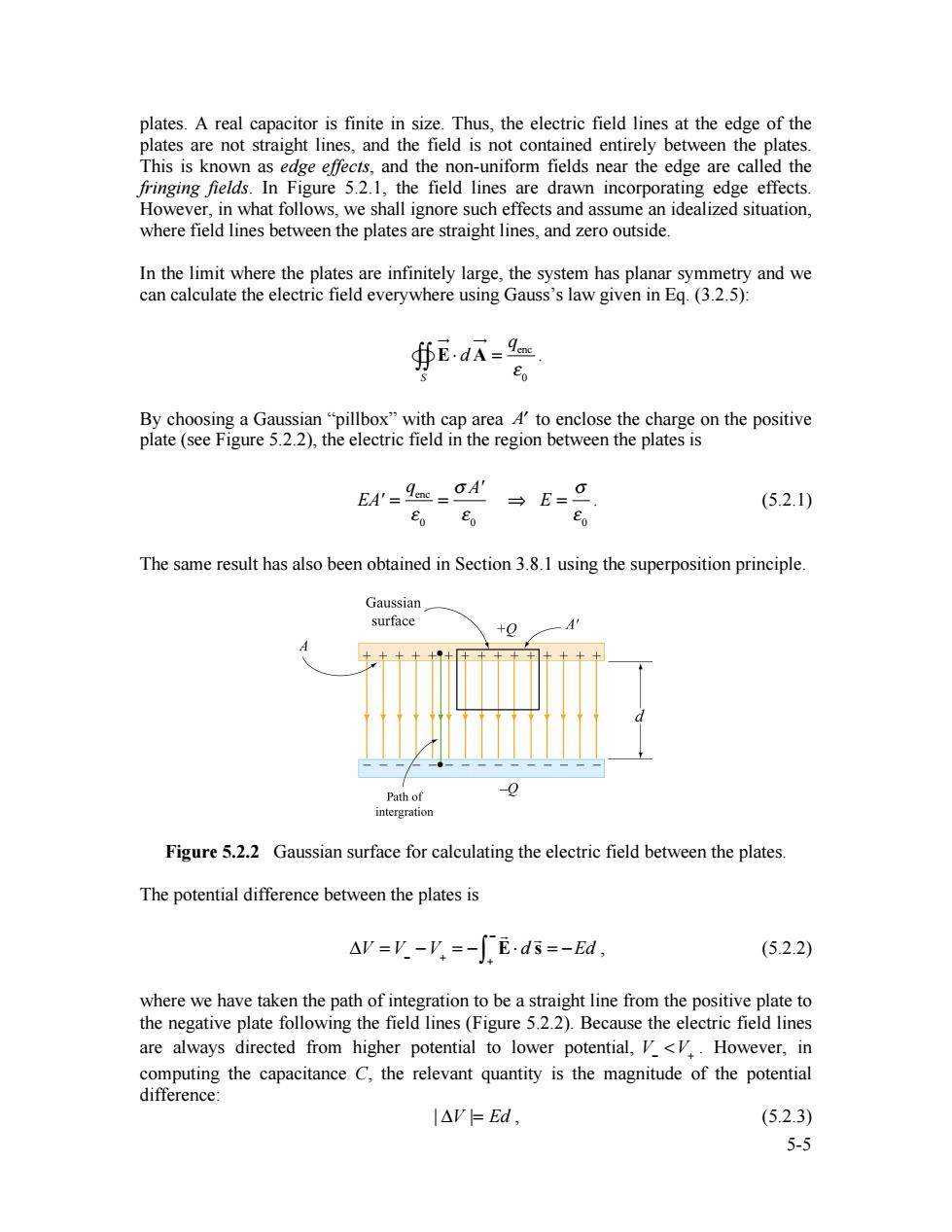
plates.A real capacitor is finite in size.Thus,the electric field lines at the edge of the plates are not straight lines,and the field is not contained entirely between the plates. This is known as edge effects,and the non-uniform fields near the edge are called the fringing fields.In Figure 5.2.1,the field lines are drawn incorporating edge effects However,in what follows,we shall ignore such effects and assume an idealized situation, where field lines between the plates are straight lines,and zero outside. In the limit where the plates are infinitely large,the system has planar symmetry and we can calculate the electric field everywhere using Gauss's law given in Eq.(3.2.5): ∯EdA=9 Eo By choosing a Gaussian "pillbox"with cap area A4'to enclose the charge on the positive plate (see Figure 5.2.2),the electric field in the region between the plates is EA'=9eE=A' (5.2.1) Eo →E= Eo The same result has also been obtained in Section 3.8.1 using the superposition principle. Gaussian surface +O -0 Path of intergration Figure 5.2.2 Gaussian surface for calculating the electric field between the plates. The potential difference between the plates is AV=V.-V,=-fE.ds=-Ed, (5.2.2) where we have taken the path of integration to be a straight line from the positive plate to the negative plate following the field lines(Figure 5.2.2).Because the electric field lines are always directed from higher potential to lower potential,V<V..However,in computing the capacitance C,the relevant quantity is the magnitude of the potential difference: l△V=Ed, (5.2.3) 5-5
5-5 plates. A real capacitor is finite in size. Thus, the electric field lines at the edge of the plates are not straight lines, and the field is not contained entirely between the plates. This is known as edge effects, and the non-uniform fields near the edge are called the fringing fields. In Figure 5.2.1, the field lines are drawn incorporating edge effects. However, in what follows, we shall ignore such effects and assume an idealized situation, where field lines between the plates are straight lines, and zero outside. In the limit where the plates are infinitely large, the system has planar symmetry and we can calculate the electric field everywhere using Gauss’s law given in Eq. (3.2.5): E !" ! d A !" S #"" = qenc # 0 . By choosing a Gaussian “pillbox” with cap area A! to enclose the charge on the positive plate (see Figure 5.2.2), the electric field in the region between the plates is EA' = qenc ! 0 = " A' ! 0 # E = " ! 0 . (5.2.1) The same result has also been obtained in Section 3.8.1 using the superposition principle. Figure 5.2.2 Gaussian surface for calculating the electric field between the plates. The potential difference between the plates is !V = V" "V+ = " ! E# d ! s + " $ = "Ed , (5.2.2) where we have taken the path of integration to be a straight line from the positive plate to the negative plate following the field lines (Figure 5.2.2). Because the electric field lines are always directed from higher potential to lower potential, V! <V+ . However, in computing the capacitance C, the relevant quantity is the magnitude of the potential difference: | !V |= Ed , (5.2.3)
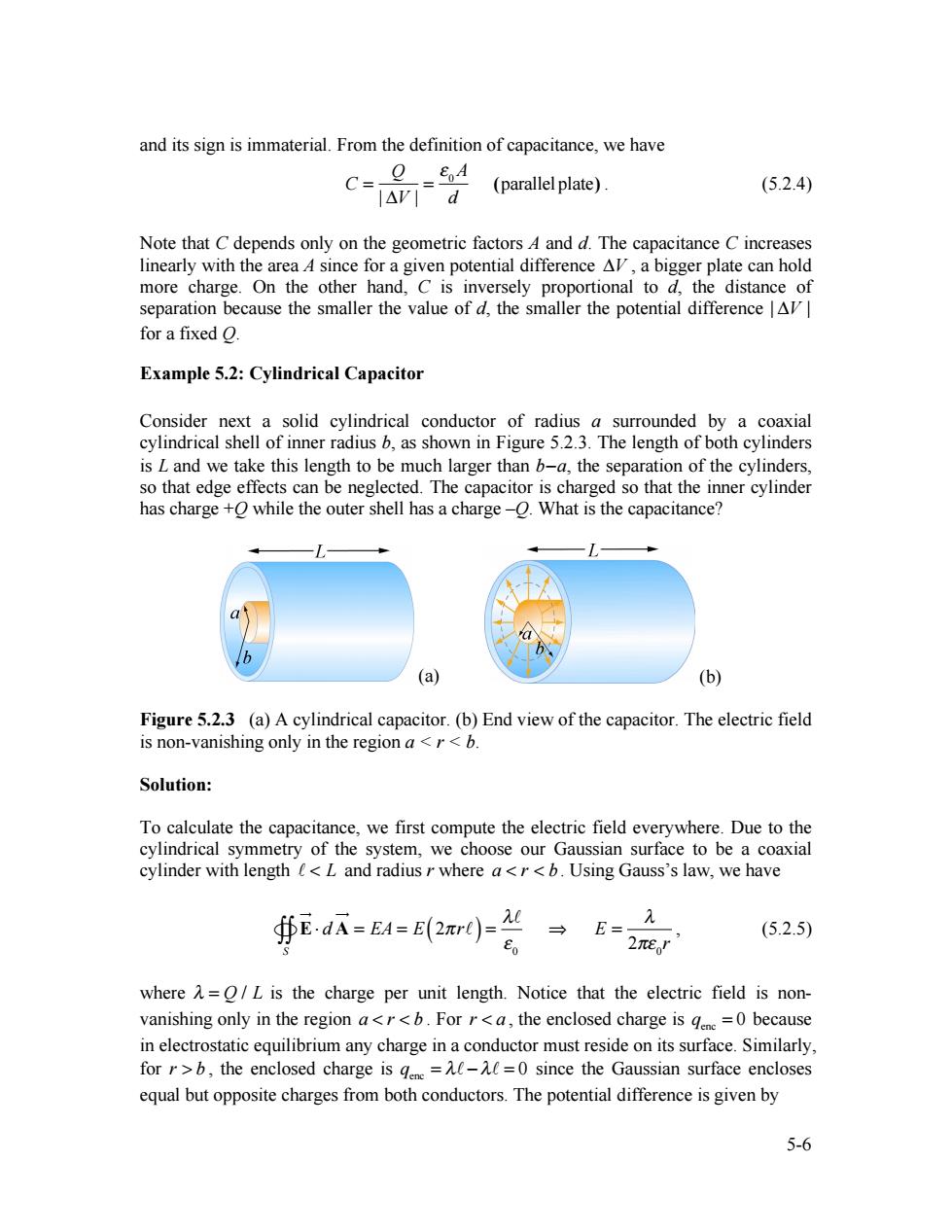
and its sign is immaterial.From the definition of capacitance,we have C= 0-£oA (parallel plate). (5.2.4) |△Vd Note that C depends only on the geometric factors 4 and d.The capacitance C increases linearly with the area 4 since for a given potential difference Al,a bigger plate can hold more charge.On the other hand,C is inversely proportional to d,the distance of separation because the smaller the value of d,the smaller the potential difference Al for a fixed O. Example 5.2:Cylindrical Capacitor Consider next a solid cylindrical conductor of radius a surrounded by a coaxial cylindrical shell of inner radius b,as shown in Figure 5.2.3.The length of both cylinders is L and we take this length to be much larger than b-a,the separation of the cylinders, so that edge effects can be neglected.The capacitor is charged so that the inner cylinder has charge +O while the outer shell has a charge-O.What is the capacitance? (a) (b) Figure 5.2.3 (a)A cylindrical capacitor.(b)End view of the capacitor.The electric field is non-vanishing only in the region a <r<b. Solution: To calculate the capacitance,we first compute the electric field everywhere.Due to the cylindrical symmetry of the system,we choose our Gaussian surface to be a coaxial cylinder with length <L and radius r where a<r<b.Using Gauss's law,we have ∯EdA=EA=E(2r)=2L E=- (5.2.5) 2πer where =/L is the charge per unit length.Notice that the electric field is non- vanishing only in the region a<r<b.For r<a,the enclosed charge is =0 because in electrostatic equilibrium any charge in a conductor must reside on its surface.Similarly, for rb,the enclosed charge is ene==0 since the Gaussian surface encloses equal but opposite charges from both conductors.The potential difference is given by 5-6
5-6 and its sign is immaterial. From the definition of capacitance, we have C = Q | !V | = " 0A d (parallelplate) . (5.2.4) Note that C depends only on the geometric factors A and d. The capacitance C increases linearly with the area A since for a given potential difference !V , a bigger plate can hold more charge. On the other hand, C is inversely proportional to d, the distance of separation because the smaller the value of d, the smaller the potential difference | !V | for a fixed Q. Example 5.2: Cylindrical Capacitor Consider next a solid cylindrical conductor of radius a surrounded by a coaxial cylindrical shell of inner radius b, as shown in Figure 5.2.3. The length of both cylinders is L and we take this length to be much larger than b−a, the separation of the cylinders, so that edge effects can be neglected. The capacitor is charged so that the inner cylinder has charge +Q while the outer shell has a charge –Q. What is the capacitance? (a) (b) Figure 5.2.3 (a) A cylindrical capacitor. (b) End view of the capacitor. The electric field is non-vanishing only in the region a b , the enclosed charge is enc q = !! " !! = 0 since the Gaussian surface encloses equal but opposite charges from both conductors. The potential difference is given by
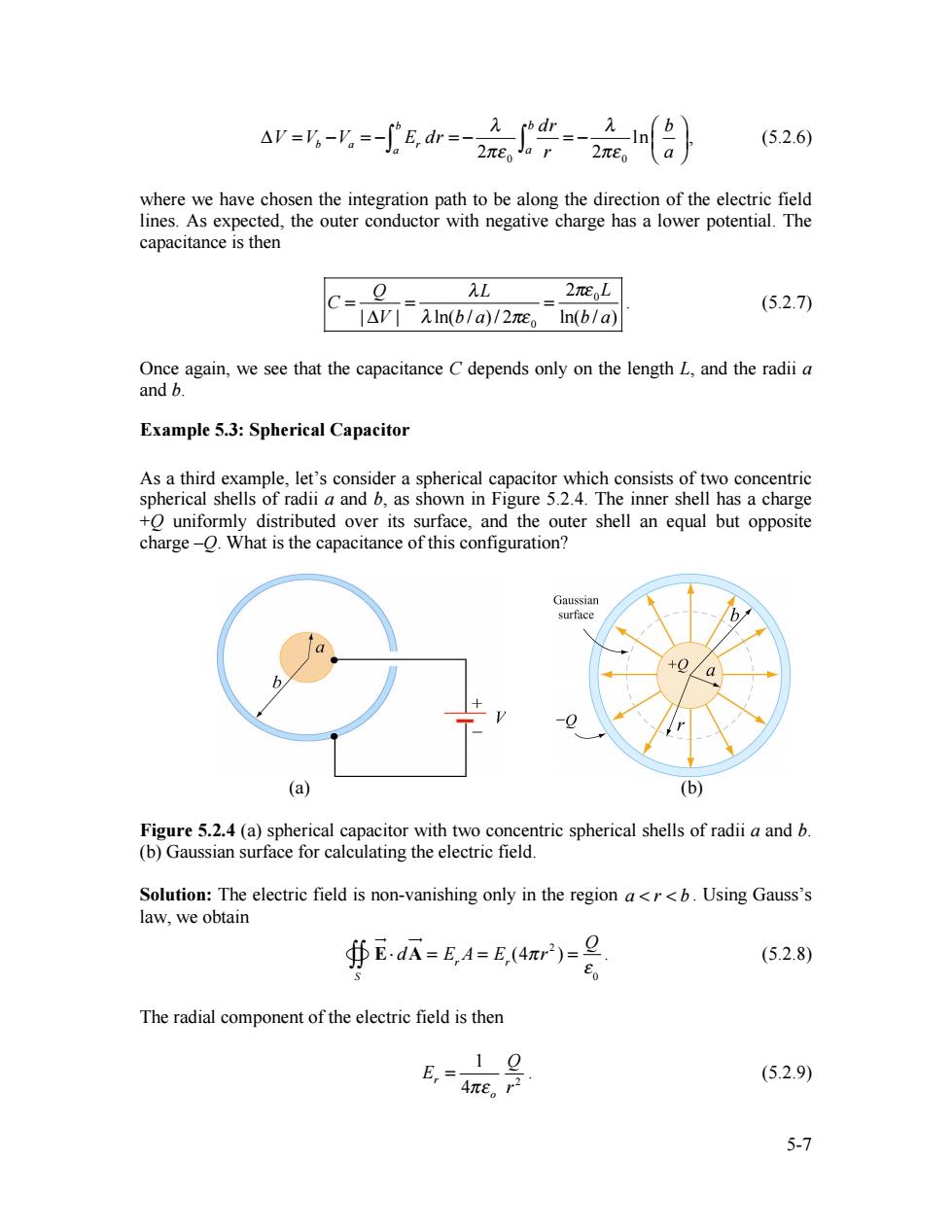
(5.2.6) where we have chosen the integration path to be along the direction of the electric field lines.As expected,the outer conductor with negative charge has a lower potential.The capacitance is then Q AL 2πeL C= (5.2.7) |△'|2ln(b/a)/2re。ln(b/a) Once again,we see that the capacitance C depends only on the length L,and the radii a and b. Example 5.3:Spherical Capacitor As a third example,let's consider a spherical capacitor which consists of two concentric spherical shells of radii a and b,as shown in Figure 5.2.4.The inner shell has a charge +O uniformly distributed over its surface,and the outer shell an equal but opposite charge-O.What is the capacitance of this configuration? Gaussian surface 0 (a) (b) Figure 5.2.4 (a)spherical capacitor with two concentric spherical shells of radii a and b. (b)Gaussian surface for calculating the electric field. Solution:The electric field is non-vanishing only in the region a<r<b.Using Gauss's law,we obtain ∯E,=E4-E4红)=号 (5.2.8) The radial component of the electric field is then E.= 1 (5.2.9) 4πe。r2 5-7
5-7 0 0 ln 2 2 b b a r a b a dr b V V V E dr r a ! ! "# "# $ % & = ' = ' = ' = ' ( ) * + , , , (5.2.6) where we have chosen the integration path to be along the direction of the electric field lines. As expected, the outer conductor with negative charge has a lower potential. The capacitance is then 0 0 2 | | ln( / )/ 2 ln( / ) Q L L C V b a b a # !" # !" = = = $ . (5.2.7) Once again, we see that the capacitance C depends only on the length L, and the radii a and b. Example 5.3: Spherical Capacitor As a third example, let’s consider a spherical capacitor which consists of two concentric spherical shells of radii a and b, as shown in Figure 5.2.4. The inner shell has a charge +Q uniformly distributed over its surface, and the outer shell an equal but opposite charge –Q. What is the capacitance of this configuration? (a) (b) Figure 5.2.4 (a) spherical capacitor with two concentric spherical shells of radii a and b. (b) Gaussian surface for calculating the electric field. Solution: The electric field is non-vanishing only in the region a < r < b . Using Gauss’s law, we obtain E !" ! dA !" S #"" = Er A = Er (4# r 2 ) = Q $ 0 . (5.2.8) The radial component of the electric field is then 2 1 4 r o Q E !" r = . (5.2.9)
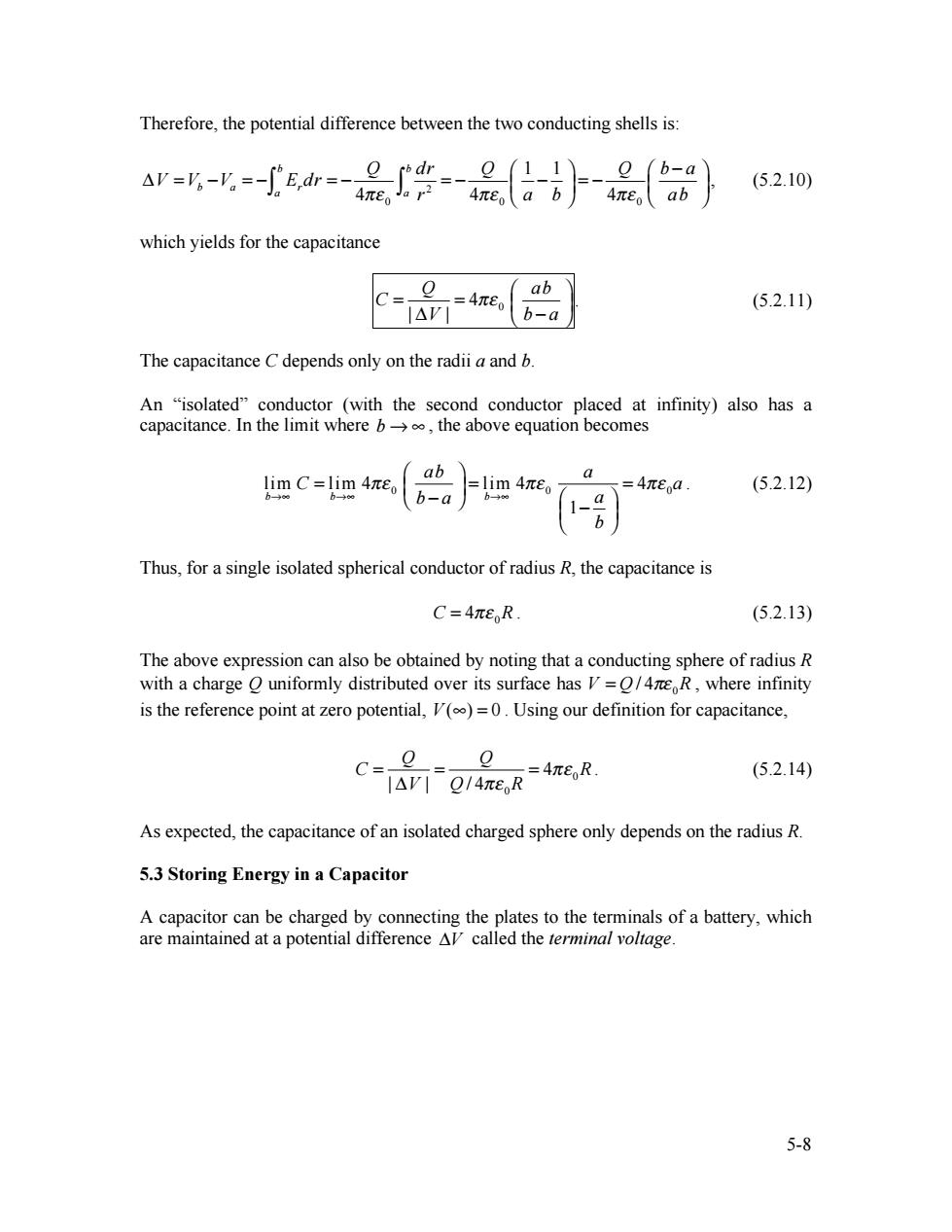
Therefore,the potential difference between the two conducting shells is: (5.2.10) which yields for the capacitance Q =4πe0 ab C (5.2.11) I△VI b-a The capacitance C depends only on the radii a and b. An "isolated"conductor (with the second conductor placed at infinity)also has a capacitance.In the limit where b→∞,the above equation becomes ab lim C=lim b-a lim4πeo 4πeoa (5.2.12) Thus,for a single isolated spherical conductor of radius R,the capacitance is C=4πeoR. (5.2.13) The above expression can also be obtained by noting that a conducting sphere of radius R with a charge O uniformly distributed over its surface has V=O/4eR,where infinity is the reference point at zero potential,V()=0.Using our definition for capacitance, C=0 Q -=4πeR. (5.2.14) I△V|Q/4πeoR As expected,the capacitance of an isolated charged sphere only depends on the radius R. 5.3 Storing Energy in a Capacitor A capacitor can be charged by connecting the plates to the terminals of a battery,which are maintained at a potential difference AV called the terminal voltage. 5-8
5-8 Therefore, the potential difference between the two conducting shells is: 2 0 0 0 1 1 4 4 4 b b b a r a a Q dr Q Q b a V V V E dr !" r !" a b !" ab $ % $ # % & = # = # = # = # ' # ( = # ' ( ) * ) * + + , (5.2.10) which yields for the capacitance 0 4 | | Q ab C V b a !" # $ = = % & ' ) ( * . (5.2.11) The capacitance C depends only on the radii a and b. An “isolated” conductor (with the second conductor placed at infinity) also has a capacitance. In the limit where b " ! , the above equation becomes 0 0 0 lim lim 4 lim 4 4 1 b b b ab a C a b a a b !" !" !" #$ #$ #$ % & = ' ( = = * ) + % & ' ) ( * + . (5.2.12) Thus, for a single isolated spherical conductor of radius R, the capacitance is 0 C = 4!" R . (5.2.13) The above expression can also be obtained by noting that a conducting sphere of radius R with a charge Q uniformly distributed over its surface has 0 V = Q / 4!" R , where infinity is the reference point at zero potential, V (!) = 0 . Using our definition for capacitance, 0 0 4 | | / 4 Q Q C R V Q R !" !" = = = # . (5.2.14) As expected, the capacitance of an isolated charged sphere only depends on the radius R. 5.3 Storing Energy in a Capacitor A capacitor can be charged by connecting the plates to the terminals of a battery, which are maintained at a potential difference !V called the terminal voltage
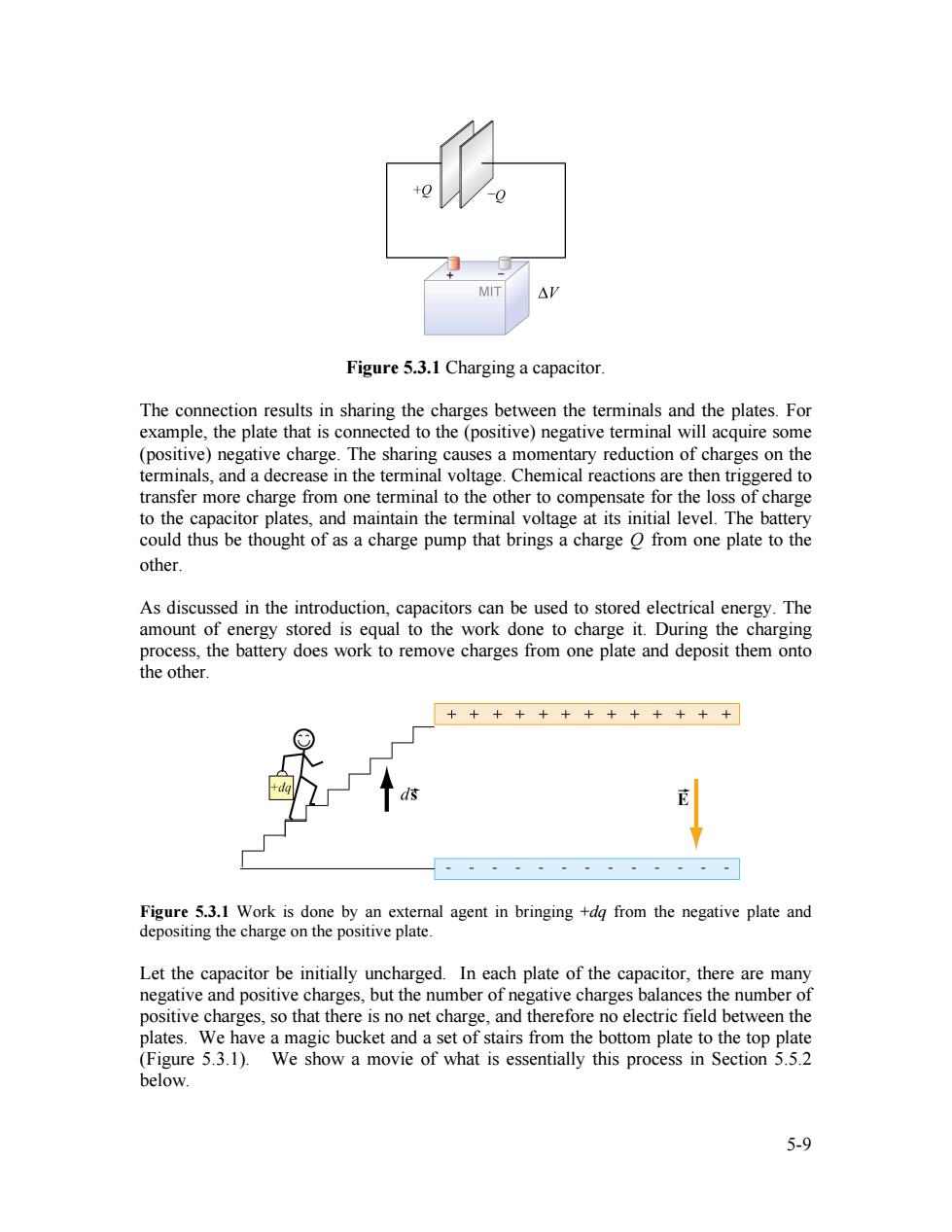
MIT Figure 5.3.1 Charging a capacitor. The connection results in sharing the charges between the terminals and the plates.For example,the plate that is connected to the (positive)negative terminal will acquire some (positive)negative charge.The sharing causes a momentary reduction of charges on the terminals,and a decrease in the terminal voltage.Chemical reactions are then triggered to transfer more charge from one terminal to the other to compensate for the loss of charge to the capacitor plates,and maintain the terminal voltage at its initial level.The battery could thus be thought of as a charge pump that brings a charge o from one plate to the other. As discussed in the introduction,capacitors can be used to stored electrical energy.The amount of energy stored is equal to the work done to charge it.During the charging process,the battery does work to remove charges from one plate and deposit them onto the other. +十+++++++++++ Figure 5.3.1 Work is done by an external agent in bringing +dg from the negative plate and depositing the charge on the positive plate. Let the capacitor be initially uncharged.In each plate of the capacitor,there are many negative and positive charges,but the number of negative charges balances the number of positive charges,so that there is no net charge,and therefore no electric field between the plates.We have a magic bucket and a set of stairs from the bottom plate to the top plate (Figure 5.3.1).We show a movie of what is essentially this process in Section 5.5.2 below. 5-9
5-9 Figure 5.3.1 Charging a capacitor. The connection results in sharing the charges between the terminals and the plates. For example, the plate that is connected to the (positive) negative terminal will acquire some (positive) negative charge. The sharing causes a momentary reduction of charges on the terminals, and a decrease in the terminal voltage. Chemical reactions are then triggered to transfer more charge from one terminal to the other to compensate for the loss of charge to the capacitor plates, and maintain the terminal voltage at its initial level. The battery could thus be thought of as a charge pump that brings a charge Q from one plate to the other. As discussed in the introduction, capacitors can be used to stored electrical energy. The amount of energy stored is equal to the work done to charge it. During the charging process, the battery does work to remove charges from one plate and deposit them onto the other. Figure 5.3.1 Work is done by an external agent in bringing +dq from the negative plate and depositing the charge on the positive plate. Let the capacitor be initially uncharged. In each plate of the capacitor, there are many negative and positive charges, but the number of negative charges balances the number of positive charges, so that there is no net charge, and therefore no electric field between the plates. We have a magic bucket and a set of stairs from the bottom plate to the top plate (Figure 5.3.1). We show a movie of what is essentially this process in Section 5.5.2 below
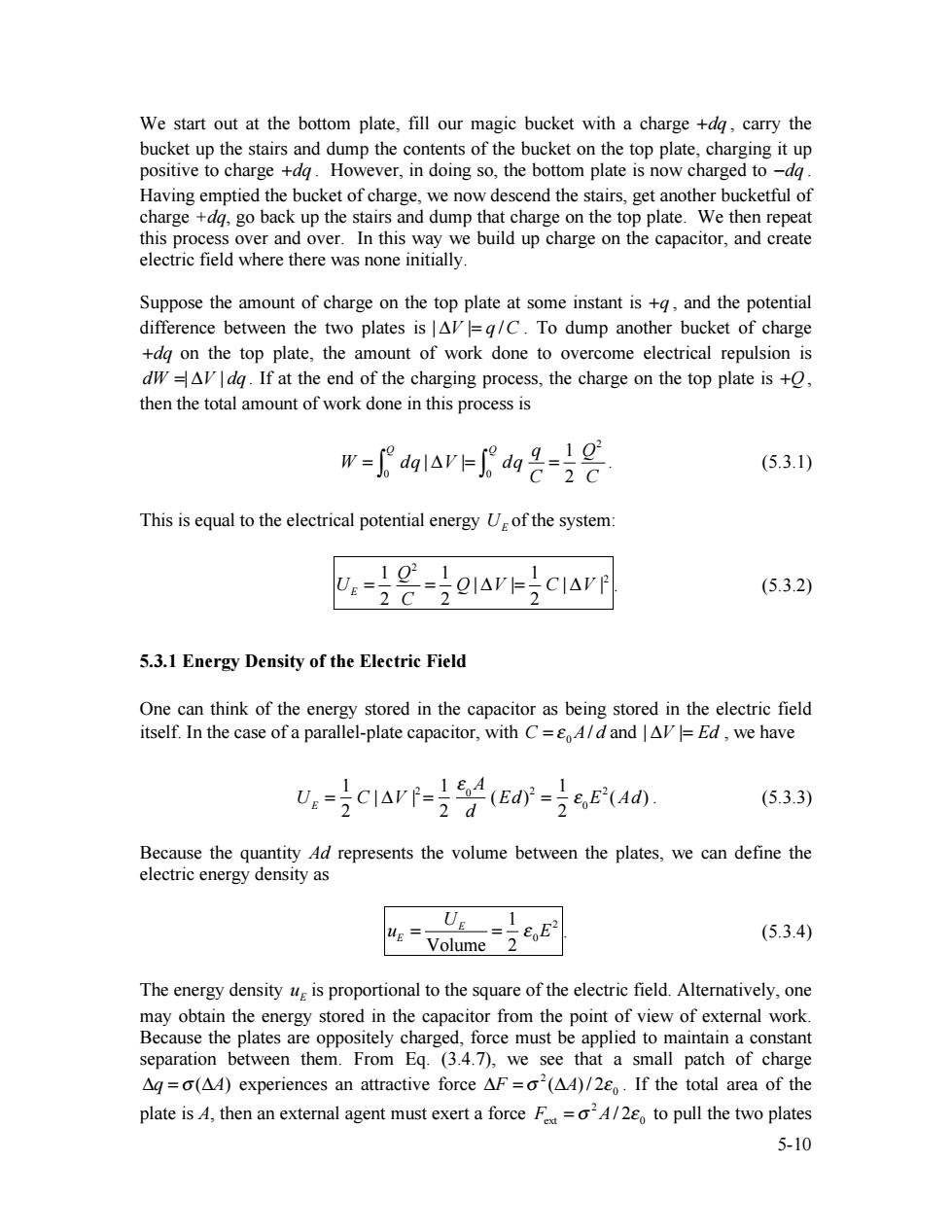
We start out at the bottom plate,fill our magic bucket with a charge +dg,carry the bucket up the stairs and dump the contents of the bucket on the top plate,charging it up positive to charge +dg.However,in doing so,the bottom plate is now charged to -dg. Having emptied the bucket of charge,we now descend the stairs,get another bucketful of charge +dg,go back up the stairs and dump that charge on the top plate.We then repeat this process over and over.In this way we build up charge on the capacitor,and create electric field where there was none initially. Suppose the amount of charge on the top plate at some instant is +g,and the potential difference between the two plates is Al=g/C.To dump another bucket of charge +dg on the top plate,the amount of work done to overcome electrical repulsion is dw=AVdg.If at the end of the charging process,the charge on the top plate is + then the total amount of work done in this process is m-1ar=是-是 (5.3.1) This is equal to the electrical potential energy Ue of the system: U,-1-QIAYHCIAPP 2C2 (5.3.2) 5.3.1 Energy Density of the Electric Field One can think of the energy stored in the capacitor as being stored in the electric field itself.In the case of a parallel-plate capacitor,with C=4/d and AV =Ed,we have U.CIAP() (5.3.3) Because the quantity Ad represents the volume between the plates,we can define the electric energy density as u E UE= (5.3.4) Volume 2 The energy density u is proportional to the square of the electric field.Alternatively,one may obtain the energy stored in the capacitor from the point of view of external work. Because the plates are oppositely charged,force must be applied to maintain a constant separation between them.From Eq.(3.4.7),we see that a small patch of charge Ag=(A4)experiences an attractive force AF=(AA)/2.If the total area of the plate is A,then an external agent must exert a force F=2A/2 to pull the two plates 5-10
5-10 We start out at the bottom plate, fill our magic bucket with a charge +dq , carry the bucket up the stairs and dump the contents of the bucket on the top plate, charging it up positive to charge +dq . However, in doing so, the bottom plate is now charged to !dq . Having emptied the bucket of charge, we now descend the stairs, get another bucketful of charge +dq, go back up the stairs and dump that charge on the top plate. We then repeat this process over and over. In this way we build up charge on the capacitor, and create electric field where there was none initially. Suppose the amount of charge on the top plate at some instant is +q , and the potential difference between the two plates is | !V |= q /C . To dump another bucket of charge +dq on the top plate, the amount of work done to overcome electrical repulsion is dW =| !V | dq . If at the end of the charging process, the charge on the top plate is +Q , then the total amount of work done in this process is 2 0 0 1 | | 2 Q Q q Q W dq V dq C C = ! = = " " . (5.3.1) This is equal to the electrical potential energy UE of the system: 2 1 1 1 2 | | | | 2 2 2 E Q U Q V C V C = = ! = ! . (5.3.2) 5.3.1 Energy Density of the Electric Field One can think of the energy stored in the capacitor as being stored in the electric field itself. In the case of a parallel-plate capacitor, with 0 C = ! A/ d and | !V |= Ed , we have UE = 1 2 C | !V | 2 = 1 2 " 0A d (Ed) 2 = 1 2 " 0E2 (Ad) . (5.3.3) Because the quantity Ad represents the volume between the plates, we can define the electric energy density as 2 0 1 Volume 2 E E U u = = ! E . (5.3.4) The energy density E u is proportional to the square of the electric field. Alternatively, one may obtain the energy stored in the capacitor from the point of view of external work. Because the plates are oppositely charged, force must be applied to maintain a constant separation between them. From Eq. (3.4.7), we see that a small patch of charge "q = ! ("A) experiences an attractive force 2 0 #F = ! (#A)/ 2" . If the total area of the plate is A, then an external agent must exert a force 2 ext 0 F = ! A/ 2" to pull the two plates